

Kasdin says he believes one important reason why companies are setting up shop in Miami Beach is because of its high quality of life - a small residential community with historic neighborhoods and a culturally diverse population brought together in the two realms that truly define Miami Beach - the cultural arts and world-renowned nightlife. We’ve become the media hub of the Americas.” We have television companies, record labels, Internet ventures. “One of my biggest surprises,” Kasdin says, “has been the development of Miami Beach as a business and media center. It is also a world-class cultural arts center and a hub for media, entertainment and Internet companies. A big part of the reason why it attracts eight million visitors a year - 80% of the tourists who come to Miami-Dade County - is that it is more than a palm-lined beach resort. Today, Kasdin points out, Miami Beach is much more than just another hot tourist destination. “The rest is history,” Kasdin says with a proud smile. A seasonal population of models followed, and then Europeans drawn by the emerging Bohemian trendiness. In the mid-1980’s, Kasdin explains, the fashion-photo industry discovered South Beach for its magical winter light and warm climate. “Except for the fact that there was a depressed real estate market in the early ’80’s and we also had a vigorous preservation advocacy movement,” Kasdin says today, “these wonderful buildings wouldn’t be sitting here and we wouldn’t be sitting here either.” Back then, however, the threat of the bulldozer was a daily menace to Kasdin and his fellow preservationists. Today, of course, it is hard to believe anyone could have been so misguided. Instead of preserving and restoring South Beach’s unique architectural heritage, the developers and their political allies wanted to erect high-rise towers, bring in casino gambling and open fabled pedestrian mall Lincoln Road to vehicular traffic. They thought we were nuts.” Mayor Kasdin with News Cafe owner Mark Soyka When you mentioned preservation, they said, ‘What are you talking about?’ They didn’t know about Art deco and they didn’t see its potential. “You had to be there to understand how out of touch the civic and business and political leadership of the community was at that time.

“A new, glistening and failed resort,” Kasdin says with a laugh over coffee at the Raleigh Hotel, whose renovation in 1990 was another critical moment in the long South Beach renaissance. Kasdin notes that the city fathers of that era, along with aggressive real estate developers, wanted to bulldoze the dilapidated Art Deco buildings and build a new, glistening resort.

We just didn’t realize how special it was.” But I don’t think anyone in the early years thought it would grow to the extent it has grown to. “Even then,” he says, “I was very bullish on South Beach. Throughout the 1980’s, he worked in the historic preservation movement and chaired a campaign to approve a bond issue to revitalize boarded-up and largely abandoned Ocean Drive. “I always believed there would be a renaissance,” says Kasdin, who got elected to the city commission in 1991 and won the mayor’s seat in 1997. Born on the Beach to parents who also played significant roles in the history of Miami Beach, Kasdin began his public service career in 1980 when, fresh out of the University of Florida Law School, he joined the historic preservation movement that would become the salvation of the Art Deco architectural treasure that is South Beach. Long before he became mayor of the City of Miami Beach in 1997, Neisen Kasdin had a hand in its transformation from run-down tropical rest home to red-hot international resort destination.


 0 kommentar(er)
0 kommentar(er)
